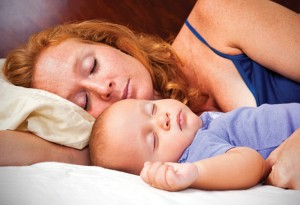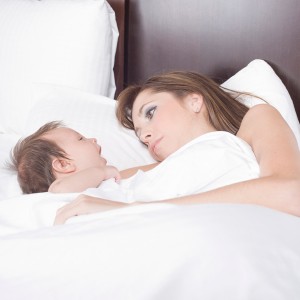Is Co-Sleeping a Healthy Habit?
 Making sure your newborn has the safest sleeping environment is essential to helping him/her grow up strong and healthy. Sleep habits are a prevalent topic of conversation among new moms and dads, as optimizing the quantity and quality of sleep is vital to an infant’s wellbeing (and mom and dad’s, for that matter). Unlike their exhausted new parents, babies sleep or drowse between 16 and 20 hours each day until 6 months of age. All that sleep, paired with frequent feedings and diaper changes, often makes parents question if co-sleeping might be beneficial for both, the baby and them.
Making sure your newborn has the safest sleeping environment is essential to helping him/her grow up strong and healthy. Sleep habits are a prevalent topic of conversation among new moms and dads, as optimizing the quantity and quality of sleep is vital to an infant’s wellbeing (and mom and dad’s, for that matter). Unlike their exhausted new parents, babies sleep or drowse between 16 and 20 hours each day until 6 months of age. All that sleep, paired with frequent feedings and diaper changes, often makes parents question if co-sleeping might be beneficial for both, the baby and them.
Co-sleeping is the term used to describe a parent and infant sharing a bed or other sleeping surface (couch, reclining chair, etc.). The practice of co-sleeping—specifically positioning baby and parent side-by-side in the bed—is popular in many cultures, but research suggests this arrangement can create serious health risks. There are often cultural and personal reasons as to why parents choose co-sleeping. Here are some of the pros and cons:
Pros
- Increases bonding between mother and child.
- Facilitates breastfeeding thanks to the proximity and convenience.
- Makes baby’s other needs (comforting, diaper changes, etc.) easier for the parent to fulfill.
Cons
- Accidental infanticide—rolling over the baby, causing suffocation, physical injury, or even death
- Increased risk of sudden infant death syndrome (SIDS); especially if the baby suffers from heart or lung problems
- Increased risk of overheating, rebreathing, or airway obstruction
- Additional evidence suggests that the risk of SIDS increases even further if the co-sleeping parent smokes or has recently consumed alcohol, the infant is younger than 3 months, blankets or other soft-bedding accessories are used, there are multiple bed sharers, or the other bed sharer is not a parent.
There are, however, safe ways to co-sleep with your baby without actually sharing a sleeping surface. Placing a crib or bassinet near the parent’s bed allows the infant to be in close proximity, while preventing possible suffocation, strangulation or entrapment. This method, often known as room-sharing, drastically decreases the risk of SIDS (by more than 50 percent). The American Academy of Pediatrics (AAP) recommends room-sharing as the preferred sleeping arrangement for parents and their newborns and considers it safer than solitary sleeping (when the infant is in a separate room). Room-sharing also facilitates feeding, comforting, and monitoring of the newborn.
Aside from room-sharing, additional safety tips have been advised by the AAP (and supported by  Nemours Children’s Hospital) to ensure that parents prepare the safest sleeping arrangement possible for their newborn. A baby’s sleep position plays a major factor in his or her safety and the AAP recommends that healthy infants sleep on their backs, not their stomachs; thus significantly lowering the risk of SIDS. Proper location and position are crucial to safe-sleeping habits for newborns, as is having the ideal sleep surface and surroundings. According to the U.S. Consumer Product Safety Commission, a number of infant deaths have been related to bumper pads in cribs. Thus, parents are urged to choose a firm mattress for their baby and not place anything in the crib or bassinet that could interfere with the infant’s breathing, such as: plush toys, pillows, blankets, or bumper pads.
Nemours Children’s Hospital) to ensure that parents prepare the safest sleeping arrangement possible for their newborn. A baby’s sleep position plays a major factor in his or her safety and the AAP recommends that healthy infants sleep on their backs, not their stomachs; thus significantly lowering the risk of SIDS. Proper location and position are crucial to safe-sleeping habits for newborns, as is having the ideal sleep surface and surroundings. According to the U.S. Consumer Product Safety Commission, a number of infant deaths have been related to bumper pads in cribs. Thus, parents are urged to choose a firm mattress for their baby and not place anything in the crib or bassinet that could interfere with the infant’s breathing, such as: plush toys, pillows, blankets, or bumper pads.
There are no secret remedies or magic tricks to get an infant on a precise sleeping schedule; yet establishing a routine will help a baby to understand that nighttime is for sleeping. Any soothing activities consistently performed each night will help a baby associate these actions as the time to wind down. Also, building a good sleep pattern during infancy can help combat future issues surrounding lack of sleep in childhood, which are related to an increased risk of obesity, mood disorders, and poor school performance.
Pediatricians like to give parents as much information as possible to help them make informed decisions about co-sleeping, but it is generally understood that the risks certainly outweigh the benefits. Helping an infant sleep in the recommended position and within the proper environment is imperative for his/her health and wellbeing. For more information, visit KidsHealth.org.
Dr. Floyd R. Livingston Jr. is division chief of pediatric pulmonary medicine at Nemours Children’s Hospital in Orlando.









